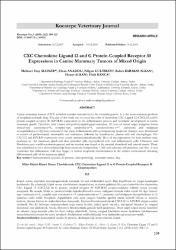| dc.contributor.author | Alçığır, Mehmet Eray | |
| dc.contributor.author | Anadol, Elvan | |
| dc.contributor.author | Gültiken, Nilgün | |
| dc.contributor.author | Karakaş Alkan, Kübra | |
| dc.contributor.author | Alkan, Hasan | |
| dc.contributor.author | Kanca, Halit | |
| dc.date.accessioned | 2019-01-30T12:00:35Z | |
| dc.date.available | 2019-01-30T12:00:35Z | |
| dc.date.issued | 2018 | |
| dc.identifier.uri | http://dergipark.gov.tr/download/article-file/422517 | |
| dc.identifier.uri | http://hdl.handle.net/11630/5291 | |
| dc.description.abstract | Köpek meme tümörleri etiyopatogenezinde karmaşık bir seri etkileşimleri içerir. Dişi köpeklerde en yaygın karşılaşılan problemdir. Bu çalışmada, köpek meme tümörlerinde yangısal süreç ve tümör gelişimde bir çeşit chemokin olan chemokine CXC Ligand 12 (CXCL12) ile G protein coupled receptor 30 (GPCR30) ekspresyonlarının rollerini ortaya koymak amaçlandı. Bu amaçla, klinik ve patomorfolojik değerlendirmeden sonra, malignant formda mikst orjinli 18 olgu (mixed-type carcinoma-n=6, complex-type carcinoma-n=3, carcinosarcoma-n=7, carcinoma and malignant myoepithelioma-n=2) çalışmaya dahil edildi. Neoplazik değişikliklere eşlik eden yangısal hücreler ağırlıklı olarak nötrofil lökosit ve sırasıyla lenfosit, plazma hücresi ile makrofajlardan oluşuyordu. İmmunohistokimyasal olarak CXCL12 ve GPCR30 ekpsresyonları skorlandı. Her iki belirteçte ekspresyonların çoğu meme bezleri, duktal epitel hücreler, miyoepitel hücreleri ile yangısal hücrelerde orta şiddetteydi. Ancak, fibrosit ve fibroblastlarda genelde hafif şiddetteydi. Mikst orjinli köpek meme tümörleri ile subakut yangı arasında yakın bir ilişki olduğu düşünüldü. Ayrıca, yangısal hücrelerin meme bezlerinin farklılaşmasını içeren hücresel çevrenin bu mikst neoplazik dönüşümünü tetikleyebileceği veya başlatabileceği sonucuna varıldı. | en_US |
| dc.description.abstract | Canine mammary tumors (CMT) included complex interactions in the etiopathogenesis. It is the most common problem of neoplasia in female dogs. The aim of this study was to reveal the roles of chemokine CXC Ligand 12 (CXCL12) and G protein coupled receptor 30 (GPCR30) expressions in the inflammatory process and neoplastic development in canine mammary glands. Therefore, after clinical and pathomorphological evaluation, 18 cases of mixed origin malignant forms (mixed-type carcinoma-n=6, complex-type carcinoma-n=3, carcinosarcoma-n=7, carcinoma and malignant myoepithelioma-n=2)] were examined in the study. Inflammatory cells accompanying neoplastic changes, were determined to consist of predominantly neutrophils and leukocytes, followed by lymphocytes, plasma cells and macrophages. The CXCL12 and GPCR30 expressions were scored. immunohistochemically. Most of the expressions for both markers were moderate in the mammary gland and duct epithelial cells, myoepithelial cells and inflammatory cells. Fibrocytes and fibroblasts gave a mild reaction in general, and no reaction was found in the myxoid, chondroid and osteoid matrix. There was considered to be a close relationship between mixed composition CMT and subacute inflammation, and thus it was concluded that inflammtory cells may trigger or initiate neoplastic transformation in the cellular environment including differentiated cells of the mammary gland. | |
| dc.language.iso | eng | en_US |
| dc.identifier.doi | 10.30607/kvj.368924 | en_US |
| dc.rights | info:eu-repo/semantics/openAccess | en_US |
| dc.subject | Şemoatraktif Sitokin | en_US |
| dc.subject | G Protein | |
| dc.subject | Klinikopatoloji | |
| dc.subject | Meme Tümörü | |
| dc.subject | Köpek | |
| dc.subject | Chemoattractive Cytokine | |
| dc.subject | G Protein | |
| dc.subject | Clinicopathology | |
| dc.subject | Mammary Tumor | |
| dc.subject | Dog | |
| dc.title | Mikst orjinli köpek meme tümörlerinde cxc chemokine ligand 12 ve g protein coupled receptor 30 ekspresyonları | en_US |
| dc.title.alternative | CXC chemokine ligand 12 and g protein-coupled receptor 30 expressions in canine mammary tumors of mixed origin | en_US |
| dc.type | article | en_US |
| dc.relation.journal | Kocatepe Veteriner Dergisi | en_US |
| dc.department | Ankara Üniversitesi, Veteriner Fakültesi | en_US |
| dc.department | Gazi Üniversitesi, Laboratuvar Hayvancılık ve Deneysel Araştırma Merkezi | |
| dc.department | Gazi Üniversitesi, Tıp Fakültesi | |
| dc.department | Ondokuzmayıs Üniversitesi, Veteriner Fakültesi | |
| dc.department | Ankara Üniversitesi, Veteriner Fakültesi | |
| dc.department | Selçuk Üniversitesi, Veteriner Fakültesi | |
| dc.identifier.volume | 11 | en_US |
| dc.identifier.startpage | 104 | en_US |
| dc.identifier.endpage | 112 | en_US |
| dc.identifier.issue | 2 | en_US |
| dc.relation.publicationcategory | Makale - Ulusal Hakemli Dergi - Kurum Yayını | en_US |



















